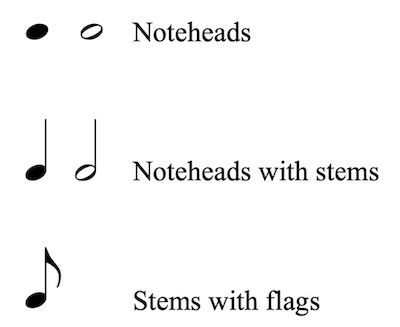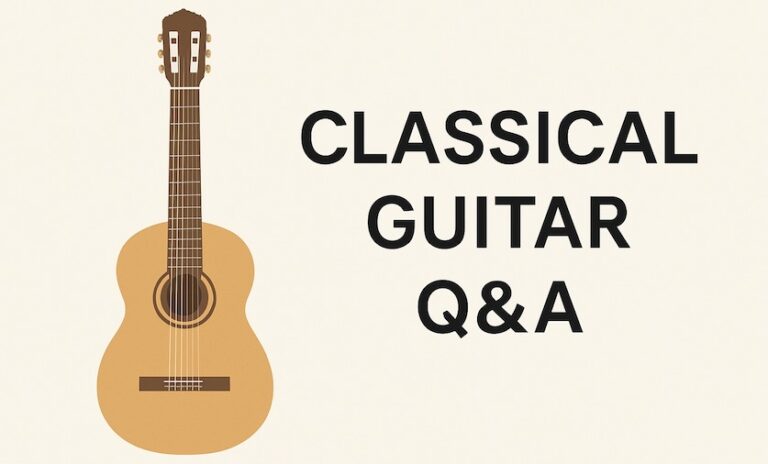This is an introduction to reading music notation on the guitar for absolute beginners. This lesson is for students starting my free PDF Classical Guitar Method Book Volume 1. Before you proceed, watch the below video by TedEd. You don’t need all of this info to start playing and you won’t remember everything but don’t worry, it’s all reviewed in my book. This page will simply help orient you to the idea of reading music notation before you begin.
Beat & Tempo
The beat, also called pulse, is the basic unit of time in a piece of music. For example, if you listen to a song and begin to tap your foot at regular intervals you are likely tapping ‘the beat’.
The word tempo is used to describe the how fast or slow the beat is moving.
Notes & Pitch
Notes are symbols used in music to represent the pitch and rhythm of a standard musical sound.
Pitch refers to how high or low a note sounds. Rhythm indicates when to play a pitch.
Anatomy of notes (below picture). Noteheads can be solid or hollow, stem or no stem, flag or no flag. You will learn about all the variations as you progress.

Notes will be placed on a staff (the five lines) as shown below.

Staff and Treble Clef
The Staff has five lines.

The Treble Clef Sign is used in guitar notation (also called the G Clef). The clef indicates which notes are represented by the lines and spaces on a staff. The bottom circular part of the treble clef designates the second to bottom line as G. There are other clefs in music, but guitar primarily uses the treble clef so that’s all you need to know for now.

A treble clef with an 8 below is often used in guitar notation. Guitar sounds one octave below where it’s written but we’ll learn more about this later so you don’t need to think about it.

Bars, also called Measures, are used to divide the staff into sections. Bar lines divide the staff into bars. Double bar lines usually mark the end of a section, final bar lines mark the end of a composition.

Time Signature
The Time Signature tells you how many beats are in each bar and what type of rhythm equals one beat. The top number states how many beats are in each bar. The bottom number states the rhythmic value of each beat. Beginners really only need to know about the top number for now. In this example the top number is indicating 4 beats per bar.

Note Names and Basic Rhythms
The image below is standard music notation starting on the lowest note of the guitar (E). The lines above and below the staff are called Ledger Lines. Ledger lines extend the range of the staff. The note names go up in the order of the musical alphabet: A – B – C – D – E – F -G and then repeat at a higher pitch.

There are actually twelve notes in music that include sharps and flats but we will learn about this later. For now, all you need to know is: A – B – C – D – E – F -G.
Memorize the basic notes on the staff
Notes can be placed on either the lines or the spaces of the staff. Below is a quick way to memorize basic notes but remember that the notes go up in the order of the alphabet as above.
Line Notes Memorization: Every Good Bear Deserves Fish.
Space Notes Memorization: FACE

Rhythm and Beat Value
Beginner, only require a simple explanation of rhythmic note values to begin. So enjoy this basic explanation and we’ll learn more later.
Quarter Notes: Solid notehead with a stem = 1 beat
Half Notes: Hollow notehead with a stem = 2 beats
Whole Notes: Hollow notehead without a stem = 4 beats
In the below example the time signature indicates 4 beats per bar, in this example I’ve written the beat out above using numbers to help you.

There are also corresponding rests that indicate silence. Rests are marked by symbols indicating the length of the pause. Each rest symbol and name corresponds to a particular rhythmic note value, indicating how long the silence should last.

You don’t need more info…but
Here’s a quick video by 12tone that will review much of the above. It’s speed will blow your mind, but again, you don’t need to know all this yet. Only watch it to get some ideas flowing and then you’ll probably forget most of it and that is ok!
That’s enough for now!
You can’t know or understand everything right away. It takes time and experience to understand what all this means and indicates for musicians. Now is the time for you to dive into my free PDF Classical Guitar Method Book Volume 1 and start playing and reading music notation. You won’t know everything, but your journey will have begun.
Come back and review this in the future and you’ll feel much more confident about all the content.
Happy practicing.



Thank you Bradford Werner.
This has been genuinely very helpful as I reintroduce myself back to classical guitar after about a decade. Thanks a lot for the frequent reassurance that we don’t have to learn the specifics all at once (but still providing the sneak peeks) as I’m still trying to overcome that particular toxic trait haha.
Okay, so, as a pianist, I have a fairly solid foundation in music, in general, and can sight read fairly well, but I know absolutely nothing at all about the guitar. It makes perfect sense then, that my first foray into composition would completely ignore the piano in favor of the guitar, flute, and cello, but that’s just sort of how these melodies are popping into my head lately. I finished my first piece, only to realize that, when I transfer the melody from flute to guitar, I start to run into range problems. The highest note I have written on the guitar line is F5, and I really really really hate to lose that note because theres a melodic line leading up to that point. Is there any way guitar can stretch up an extra note, or is e5 a hard limit? I could transpose down, but I worry about the flute and cello parts being too low…..
This is an incredible method for learning the guitar and to learn to read music.
I found the lessons very positive and helpful. I will be studying more theory for music more often. Thank you very much. Bob Taylor